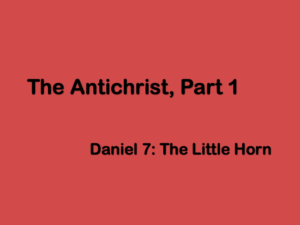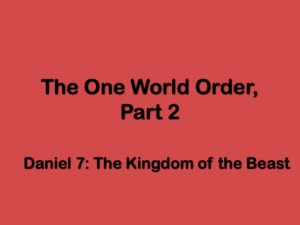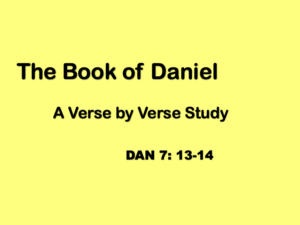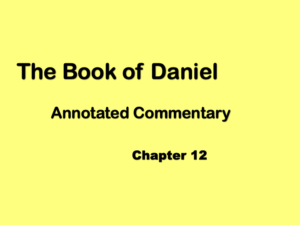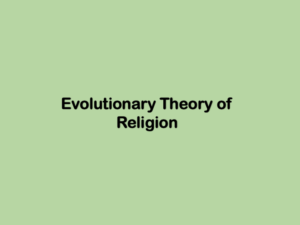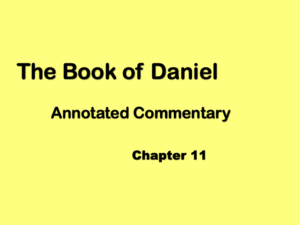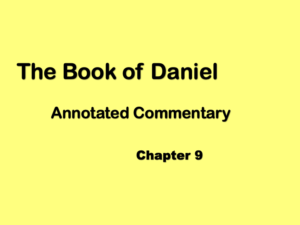Daniel 7: 15-28 The Interpretation of the Thing
In verses 1-14 of chapter 7, Daniel had a vision of four beasts arising from the sea, a court room of God, and “one like a son of man” inheriting the Kingdom of God. Now Daniel gets some additional details from a bystander.
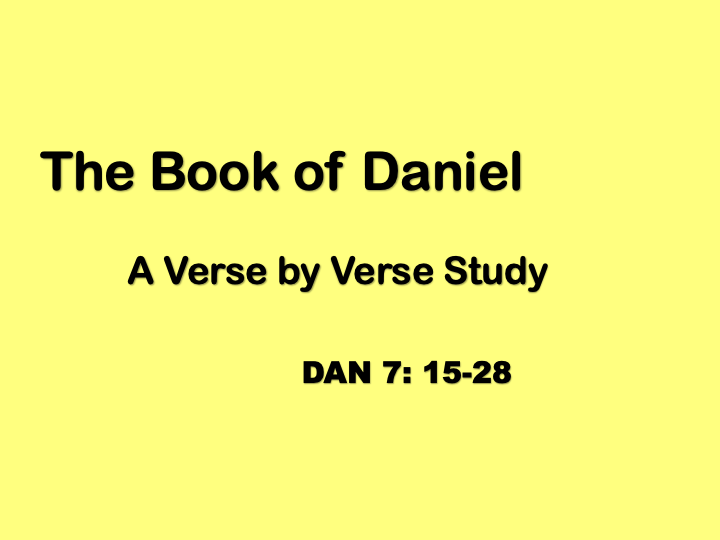
Published 17 July, 2024
After viewing the throne room of God and the judgement of the little horn, Daniel continues in his vision and asks for an interpretation.
“As for me, Daniel, my spirit was grieved within my body, and the visions of my head troubled me. I came near to one of those who stood by, and asked him the truth concerning all this.
Daniel 7: 15-16
Daniel does not identify who it is he asks for clarification. Other than the Ancient of Days and the “one like a son of man”and Daniel, the only other participants in the courtroom scene are the “thousands of thousand” who minister to the Ancient of Days and the “ten thousand times ten thousand” who stand before the Ancient of Days. The bystander must be one of these, which would make him a supernatural member of God’s court, or an angelic being. Some commentators have proposed this bystander is the angel Gabriel, since Gabriel does explain another vision to Daniel in chapter 8, but there is no way to know for sure.
Apocalyptic Literature and the Dead Sea Scrolls
The idea of a supernatural beings explaining a vision to a human observer is a common one in ancient literature. During the hundred or so years before and after the life of Jesus, a great deal of Jewish literature was written about end times and the messiah. Many of these writings were preserved among the scrolls found in the caves of Qumron (commonly called the Dead Sea scrolls). This type of literature is known as apocalyptic literature, based on the Greek word apokalupsis, which means to uncover or to reveal. Apocalyptic literature is so called because it “uncovers or reveals” information that was not previously known, usually about Biblical end times or other prophecy. Both Daniel and Revelation are an example of apocalyptic literature.
However, a great deal of apocalyptic literature was written during the time of the Dead Sea scrolls. These apocalyptic writings are part of a broader classification of Jewish writings known as second temple literature, so called because these writing occurred during the time of the second Jewish temple, which was built after the return of the Jews from Babylonian exile in the 6th century BC and was destroyed by Roman legions in 70 AD.
In apocalyptic literature, especially in apocalyptic literature form the second temple period, it was common to have an angel interpret a vision or a dream. Proponents of a late date of Daniel have argued this is evidence Daniel was written around the same time as the Dead Sea scrolls (around 2nd century BC) since Daniel and the Dead Sea scrolls share common characteristics. Proponents of an early date of Daniel (6th century BC) however, argue apocalyptic literature of the second temple period was patterned after Daniel.
Daniel’s Reaction
The fact that Daniel’s “spirit was grieved,” suggests that the four beasts are not good for Israel and the saints of the Most High. This had already been suggested by the violent nature of the imagery of the fourth beast. This is also consistent with previous books of the Old Testament where prophets warned Israel God would use foreign nations to punish them. We also learn a few verses later that the little horn will make war with saints, which can be broadly used to describe God’s believing people, which at the time of Daniel would mean Israel.
“So he told me, and made me know the interpretation of the things. ‘These great animals, which are four, are four kings, who will arise out of the earth. But the saints of the Most High will receive the kingdom, and possess the kingdom forever, even forever and ever.’
Daniel 7: 16-18
The interpreter tells Daniel the four animals represent kings. This translation follows the Masoretic text (the major Hebrew version of the Old Testament) which uses the Hebrew word malek (king). The Septuagint, the Greek translation of the Old Testament, which was popular during the time of Jesus, uses the Greek word for kingdom instead of king. This is interesting, because the description of the four animals, both in Daniel and later in Revelation, seems to use the terms king and kingdoms interchangeable. The text seems to equate the ruler of a kingdom with the kingdom itself and switch back and forth between the two terms.
Interestingly, in Daniel’s vision, the beasts came out of the sea, but the kings are described as coming out of the earth. Not a lot has been written about this discrepancy, but one possible explanation is the rulers are described as earthly in nature and not heavenly. In other words, they will be more interested in accumulating worldly wealth and power than is service to God. The mixed imagery of the sea and earth might be interpreted as the kingdom are agents of Chaos, or anti-God, and the kings are worldy, not followers of God.
Saints of the Most High
We also learn that the saints of the Most High will also be a part of God’s kingdom. The Most High is a frequent descriptor for God used in both the Old Testament and the New Testament. Its use here could be seen as a confirmation the Ancient of Days is indeed God, the Most High. The Hebrew phrase most often translated as Most High is Elohim Elyown. In this phrase, the Aramaic is El yownin. In both Hebrew and other Ancient Near Eastern languages, el is a term for a god and elohim is the plural for god (gods), although Elohim is also used for God (Genesis 1:1). Much has been written about the use of the plural Elohim for God, but it often in the Old Testament Elohim is used as a generic term for a supernatural being (Psalm 82). When God’s title of Elohim is paired with yownin, the title is comparable to the highest supernatural being. The implication is the God, the Most High, is superior and more powerful than other gods, or supernatural beings, that other people groups worship. This theme is a frequent topic in the Old Testament. Interesting, the title does suggest that these other gods are indeed actual supernatural beings. This is topic, supernatural warfare, is discussed further in chapter 10 when the angel Michael fights with the Prince of Persia.
The Aramaic word used for saints is qaddis, and the Hebrew equivalent is qados, which means holy. While there is a great deal of debate about this term, it is traditionally translated as either holy ones or saints. Also, the term can be used for believing humans but also angels. Here, that term seems to describe those who are obedient to God, the believing remnant and not angels. Those who follow God, and Jesus, will ultimately rule the earth in coordination with God. This is a return to the original state of Eden, where man lived with God, and managed the earth with God.
“Then I desired to know the truth concerning the fourth animal, which was different than all of them, exceedingly terrible, whose teeth were of iron, and its nails of brass; which devoured, broke in pieces, and stamped the residue with its feet; and concerning the ten horns that were on its head, and the other horn which came up, and before which three fell, even that horn that had eyes, and a mouth that spoke great things, whose look was more stout than its fellows.
Daniel 7: 16-20
The text again reiterates the violent language of the fourth beast, reinforcing the violent and destructive nature of this final kingdom. Daniel also repeats that a little horn will arise from the beast, the final kingdom of man, and that the Antichrist will have “eyes, and a mouth that spoke great things.” We also now learn that the little horn, the one that represents the Antichrist, will be “more stout” than the 10 horns. This suggests that ultimately he will be more powerful than his predecessors.
“I saw, and the same horn made war with the saints, and prevailed against them, until the ancient of days came, and judgement was given to the saints of the Most High, and the time came that the saints possessed the kingdom.
Daniel 7: 21-22
Now we learn the little horn will war against the saints. This detail was not included in the original description of Daniel’s vision. Since the saints are the believing followers of God, it is reasonable to believe the antichrist will also be anti-God. This idea is confirmed later in Revelation. We are also told the antichrist will “prevail” against the saints. This means that not only will the Antichrist persecute believers, but he will be allowed to do so and will be successful in his persecution. This language is consistent with other passages about a time period of judgement, known as the Day of the Lord, when God’s judgement and punishment will be executed. With this passage, we begin to get the idea that the rule of the Antichrist may be associated with the Day of the Lord.
While God allows the Antichrist to rule for a period of time, ultimately, he too will be judged, and the saints will inherit the kingdom. As we mentioned briefly previously, there is some debate about the relationship between the saints and the “one like a son of man.” The competing interpretations are either the saints and the son of man are the same group, the nation of Israel, or the son of man is the messiah and the saints are those who believe and worship God. If indeed the son of man is the messiah, which we believe he is, then the passages suggests that both the messiah and the believing followers of God will together possess the Kingdom of God.
After Daniel repeats the content of his vision, the bystander gives Daniel an explanation.
“Thus he said, ‘The fourth animal will be a fourth kingdom on earth, which will be different than all the kingdoms, and will devour the whole earth, and will tread it down, and break it in pieces. As for the ten horns, ten kings will arise out of this kingdom. Another will arise after them; and he will be different than the former, and he will speak words against the Most High, and will wear out the saints of the Most High. He will plan the change the times and the law; and they will be given into his hand until a time and times and half a time.
Daniel 7: 23-25
The interpreter confirms the fourth animal is a kingdom and then reiterates that it will be violent and it will be different than all the previous kingdoms. Daniel is also given some additional details. One is the kingdom will “devour the whole earth” in additions to being violent and destructive. A second detail is the ten horns are ten kings who will be associated with, or “arise out” of this fourth kingdom.
Daniel is also given more details about the little horn. He will come after the ten kings and will be different from them. This suggests he will not be one of the original ten kings, but will rather come to prominence after the ten kings and then “put down” three of the kings. Again, the Aramaic term for “put down” could mean a military or violent overthrow. The interpreter also confirms what was suggested by the previous language, that the little horn will speak against God, or the Most High and will persecute, or “wear out” saints of the Most High, or the believing people of God.
It is unclear how the little horn will “change the times and the law,” but some take this to be a religious reference, since the text speaks of the saints of the Most High both before and after this phrase. If this is the case, then the Antichrist may change religious laws and religious festivals (times). A more literal interpretation may be the Antichrist will try to remake the very nature of society (times and laws) as many historical authoritarian governments have tried.
Finally, we are told the Antichrist will be allowed to persecute the saints of the Most High for “time and times and half a time.” The Aramaic word for time is iddan and can mean either a definite or indefinite period of time. In this case, most scholars interpret “time” to be a definite period of one year. Following this interpretation, the time period becomes 1 year (time) plus 2 years (times) plus half a year (half a time), for a total of 3 ½ years. In Revelation, we are told the Antichrist will be allowed to persecute the believing followers of God for “time, times and half a time,” or 42 months, or 1260 days, all of which add up to 3 ½ years (when using a lunar year of 360 days). This reasoning leads us to the conclusion that the persecution of the Antichrist will last 3 ½ years.
The interpreter then turns to the Kingdom of God.
“But the judgment will be set, and they will take away his dominion, to consume and to destroy it to the end. The kingdom and the dominion, and the greatness of the kingdoms under the whole sky, will be given to the people of the saints of the Most High. His kingdom is an everlasting kingdom, and all dominions will serve and obey him.
Daniel 7: 26-27
The interpreter reinforces that they, the court, will judge the little horn and the fourth kingdom, remove them power power, and destroy the kingdom forever. After the judgement, the saints of the Most High will be given the kingdom, but we are told it will remains His (God’s) kingdom. This kingdom, the Kingdom of Heaven, will last forever and all nations and dominions will sever and obey God.
“Here is the end of the matter. As for me, Daniel, my thoughts much troubled me, and my face was changed in me: but I kept the matter in my heart.”
At the end of the vision, Daniel is troubled and weary. In a future chapter, Daniel will pray to God for clarity and understanding of the troubling times and be given another vision. But first, in Chapter 8, Daniel describes the second of the four visions he has. This one tells us more of the future kingdoms of Persia and Rome.
Previous: Daniel 7: 13-14 The Son of Man
Next: Daniel 8: 1
